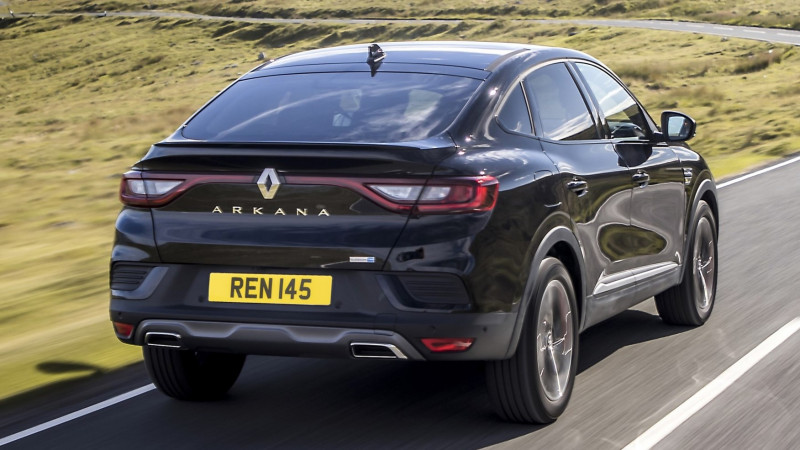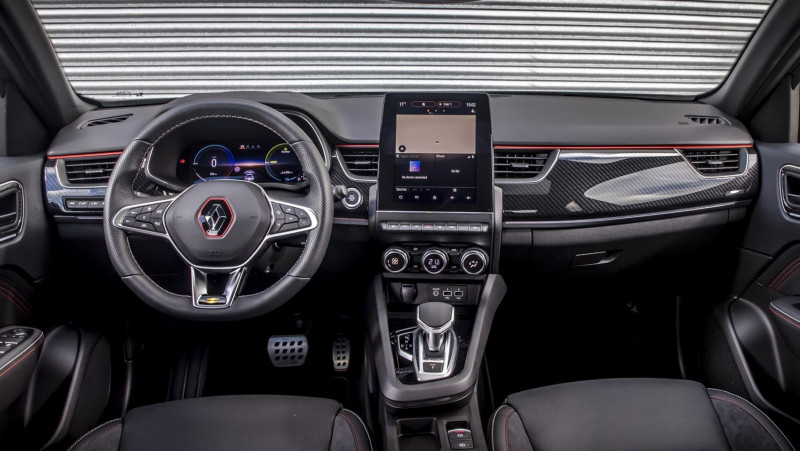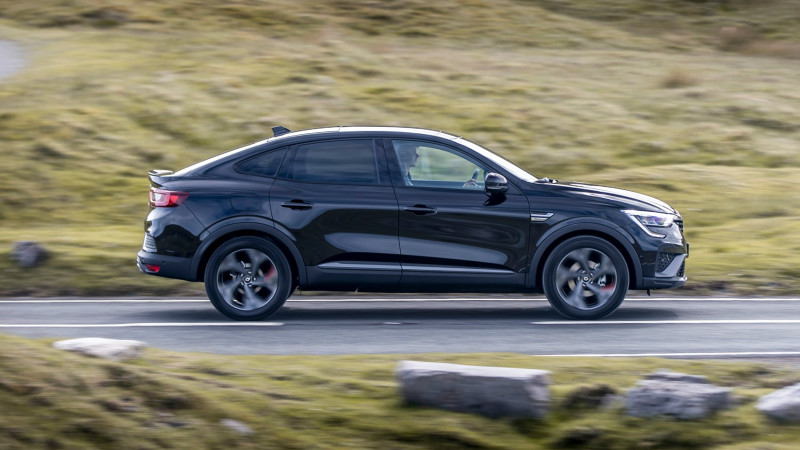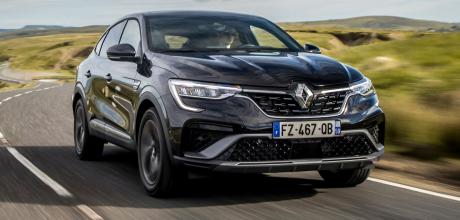2022 Renault Arkana R.S. Line E-Tech Hybrid 145 Automatic
There aren’t that many firsts left in the car world, but Renault can actually say that they are the first mainstream car maker to create a medium SUV with a coupé-esque silhouette. The premium car makers, like Audi, BMW and Mercedes-Benz have been doing it for years, multiplying the number of model variants as a result, but more stylish designs haven’t yet been tried out in the more affordable end of the market. You’ll need to find £35k for the cheapest Audi Q3 Sportback, £32k for the lowest BMW X2 and a whopping £47k if you want to get on the Mercedes-Benz GLC-Class Coupé ladder. So this range of Arkana SUV Coupé models are very much more affordable, starting at £26,300.
Sizewise, the Arkana is actually longer and lower than the Kadjar SUV, but oddly sits on the smaller Renault-Nissan-Mitsubishi Alliance CMF-B platform, that is shared with the Nissan Juke, Renault Captur and Clio. Despite Coupé-SUVs having a reputation for suffering from poorer practicality, Renault has done well to make its offering very spacious.

Renault’s approach to the Arkana has been to offer a self-charging hybrid as its economy option, rather than a more traditional diesel engine. Developed using knowledge from the Formula One arena, a small 1.2kWh traction lithium-ion battery is paired with a couple of electric motors that work together with the 1.6- litre naturally aspirated petrol engine. It has been programmed to be in use when you’re pulling away at lower speeds, or by chipping in when you need some extra oomph when accelerating. The aim is to lower the fuel consumption of the petrol engine, because the hybrid system is more regularly taking up the strain than in other rival systems. At start up, the Arkana begins in EV mode every time, to try and make lower speed manoeuvring as eco-friendly as possible. The prioritisation of the electric motor is enhanced thanks to an innovative transmission that employs a dog clutch, to balance between the eco-needs and the feel of a traditional automatic transmission with snappy responses. And while the small battery pack harnesses energy naturally while slowing down and braking, the use of the car’s B-Mode function intensifies this, with a more aggressive approach to regeneration and you can therefore drive largely just using one pedal. There are additional ways of personalising the driving experience by opting for one of the modes in the My Sense menu, including Individual, Eco and Sport settings.

Out on the road, there’s pleasing performance from the hybrid drivetrain, with a relatively quiet powertrain that you’ll only really hear when you’re making liberal use of the accelerator pedal. Tyre, road and wind noise are neatly contained, and conspire to deliver an ambience of impressive refinement. The steering is nicely response, with decent agility on twisty roads, while being utterly manoeuvrable around town. Show the Arkana a back road and it responds well, with taut, fluid handling, excellent grip, and confidence inspiring responses. There’s very little body lean, and it holds up well to anything you can chuck at it, particularly if you’re in a hurry.
The interior has a sporting flavour thanks to the red stripe above the air vents, mock carbon fibre dashboard appliqués, aluminium pedals and red stitching to the seats, safety belts and door cards. The faux-suede and leather seats are beautifully supportive and feel just a little bit more special than the norm. The digital dials are easy to read, and we like the prominence of the 9.3-inch portrait-orientated touchscreen, that is angled towards the driver. The chunky steering wheel is nice to hold and the short, stubby gear selector has a dynamic aura about it. The car’s buttons are neatly arranged in rows, and it’s easy to select the right one at a glance or when you’re in a hurry. All of the surfaces feel like they are made from good quality materials, with nice, squidgy surfaces. Oddment space is well provided for, with big door pockets, a tray in front of the gear selector, a compact area underneath the armrest and a pair of cupholders, in addition to an average-sized glovebox.

The driving position is subtly elevated, with decent levels of headroom up front, even with a sunroof fitted. For back seat occupants there’s plenty of leg and knee space and decent provision for your feet to be tucked under the front chairs, while taller occupants won’t have any problem fitting in, thanks to generous headroom. Move to the boot and there’s quite a high sill to haul luggage over, but once you do there’s 480 litres of carrying capacity with the seats up and 1,263 litres when folding down flat, if the adjustable height boot floor is in the upper position. Vision from the driver’s seat is decent up front, but thanks to a shallow rear window and bulky rear pillars, you’ll be thankful for the standard fitment of a reversing camera and front and rear parking sensors.
In addition to the self-charging hybrid edition, there’s also a 1.3-litre turbocharged mild hybrid option, though the CO2 emissions of those models put them outside the realms of Eco Car. With the Hybrid versions tested here, buyers have a choice of a trio of trim levels, from Iconic, S Edition and R.S. Line. It’s the sportiest of the three that we test here, but even the cheapest models have a long list of standard equipment, including for safety, with six airbags, autonomous emergency braking with pedestrian and cyclist detection, lane keeping assist, lane departure warning, traffic sign recognition and Isofix child safety seat fixings for the rear outer seats and front passenger seat. There’s also a rain sensor, automatic LED headlights, 17-inch alloy wheels, climate control, keyless entry and start, an electric park brake, a 7-inch infotainment screen, Android Auto and Apple CarPlay and an Arkamys audio system with six speakers.
Move up to S Edition specification and there’s the addition of larger 18-inch alloy wheels, a leather steering wheel and gear lever, slate grey front and rear skid plates, black fabric and faux leather upholstery, rear privacy glass, a larger 9.3-inch infotainment screen, navigation system, an auto-dimming rear-view mirror, blind spot warning, adaptive cruise control and rear traffic warning. At the top of the line-up is this R.S. Line model, which also adds an automatic hands-free parking system, heated steering wheel and front seats, electric height adjustment to the front chairs, an R.S. Line bodykit and leather and suede-effect seats.
“...while the small battery pack harnesses energy naturally while slowing down and braking, the use of the car’s B-Mode function intensifies this, with a more aggressive approach to regeneration.”
FACT & FIGURES
- On sale Now
- In showrooms September 2021
- Prices £26,300 to £30,900
- Bodystyles 5-door SUV
- Engines 1.6 Petrol hybrid automatic (141bhp)
- Trim levels Iconic, S Edition, R.S.Line
- Also consider Ford Kuga, Honda HR-V
- Model tested R.S. Line E-Tech Hybrid 145 Automatic
- Price £30,900
- Built in Busan, South Korea
- Codename tba
- Platform CMF-B
- Bodystyle 5-door SUV, 5-seats
- Layout Front-wheel-drive
- Powerplant 1,598cc, 4-cylinder, 16-valve, petrol with electric motor and 1.2kWh lithium-ion battery pack
- Transmission 1-speed automatic
- Max power (engine) 93bhp @ 5,600rpm
- Max power (combined) 141bhp
- Max torque (engine) 109lb ft @ 3,600rpm
- Max torque (electric motor) 184lb ft
- Top speed 107mph
- 0-62mph 10.8secs
- CO2 emissions (WLTP) 112g/km
- Economy (WLTP combined) 56.5mpg
- Fuel tank size 50 litres
- Range 622 miles
- Insurance group 16
- BIK rate (2021/2022 tax year) 26%
- Size (length/width with mirrors) 4,568/2,034mm
- Boot space (min/max) 480/1,263 litres
- Kerb/max towing weight 1,435/760kg
- Euro NCAP crash rating 5 stars
- Warranty 5 years/100,000 miles
- Wheels (Full-size/spacesaver/run-flat/self-sealing/repair kit) No/no/no/no/yes
- Verdict As one of the first coupé SUVs in the mainstream segment, it’s an interesting and roomy alternative to the norm. It’s engaging to drive, is roomy, and deserves to do well.
- EcoCar rating 9/10



Drive an original Beetle and you know all about it. It’s an engrossing, engaging experience that will live with you forever. It looked different and it felt different. For the reboot, VW ironed out everything that made it memorable and ended up with a less practical Golf with a vase in it.
The Arkana – like all manner of coupe-ish hump-backed contemporaries, from the Toyota CH-R and Fiat 500X to the considerably more expensive BMW X6 – looks more different than it feels. Priced from £25,300, it’s a standalone model, made in Korea, with styling inspired by a Russian-market Renault but fresh underpinnings, shared with the smaller Clio and Captur. We get two powertrains (this E-Tech 145 hybrid, or a mild hybrid) and three trim levels.
Renault’s E-Tech hybrid system claims to use energy-recovery know-how from the Renault (now Alpine) F1 team. The aim is seamless transitions between electric, hybrid and petrol power. A battery sits under the rear seats and powers an electric motor attached to the 1.6-litre petrol engine up front, supplemented by a starter-generator.
The E-Tech’s complicated automatic transmission system doesn’t have a manual shift option, but nor is it a CVT, in case you were worried. It just gets on with delivering power to the front wheels without drawing attention to itself or requiring any driver input. The Arkana corners willingly and, while rough roads can upset its firm ride, the seats are comfortable.
On all but entry-level models you get driving modes play with, but since Pure’s a little sluggish and Sport a bit sudden, you’re best off sticking with Hybrid, which is nicely responsive.
The shape isn’t just about the looks. Renault reckons it’s more efficient than a trad SUV, helping with economy and refinement, but also claiming the Arkana’s a family car inside. It is. The curve of the roof hasn’t resulted in tiny windows for the rear passengers, unlike the C-HR, which can feel gloomy in the back.
The Arkana looks and feels like a good value-for-money package. The performance isn’t going to get anyone excited, but if your priorities are style, practicality and a smattering of convenience and comfort features, welcome.
First verdict
An agreeable alternative to a Toyota CH-R, or a step up from a Fiat 500X. Rear legroom the priority, not blowing the driver’s socks off.
PLUS + Decent-value family motoring with a modern look
MINUS — Light on driving thrills; cabin is on the plain side
Looks like an BMW X4, for better and for worse
THE FIRST HOUR
1 minute Oh hang on, it’s quite big. Like the Hyundai Ioniq 5, it looks smaller in pictures than it is
2 minutes Mmm. Compared to the current Clio and Captur, this isn’t the most modern or imaginative of interiors
5 minutes That ‘multi-mode’ transmission isn’t, it turns out, a CVT hiding behind a different name
12 minutes Ride is firm but handling pretty good as a result. Not that the powertrain demands much
42 minutes Nice and roomy in the back, and not gloomy like a CH-R